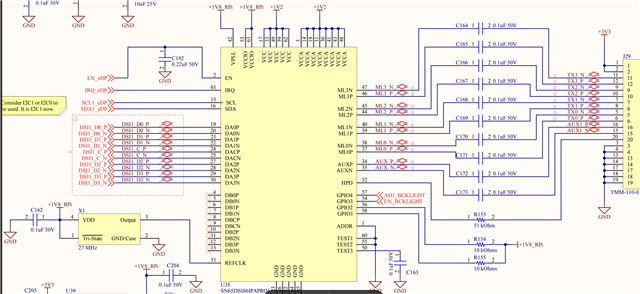Tool/software:
Hi everyone,
I'm working on interfacing a TI SN65DSI86 DSI-to-eDP bridge chip with a Raspberry Pi Compute Module 4 and an NT156FHM-N41 eDP panel.
I've successfully verified the data path by displaying a test bar pattern on the panel, so the basic connectivity seems okay. However, I'm running into an issue with the AUX channel communication between the bridge chip and the panel.
Here's the situation:
- The eDP protocol uses AUX lines (AUX_P/N) for control communication, including EDID and DPCD retrieval.
- The Linux kernel driver on the Raspberry Pi attempts to use this AUX channel to get the EDID information for display initialization. This is currently failing, and the display pipeline isn't being set up.
- I've written simple scripts to directly communicate with the panel via the bridge to read EDID and DPCD, but these are also failing to receive any data. This strongly suggests a problem with the AUX communication itself.
- I've already tried swapping the AUX_P and AUX_N wires with no change.
The panel I'm using is the NT156FHM-N41 (datasheet: BOE NT156FHM-N41). I'm looking for suggestions on what to investigate next to get the AUX communication working.
Could there be specific hardware considerations (like termination, pull-ups, signal integrity) I should be looking at? Are there any specific configuration settings on the SN65DSI86 that are crucial for AUX communication? Any insights or experiences with similar setups would be greatly appreciated!
Thanks in advance for your help!

